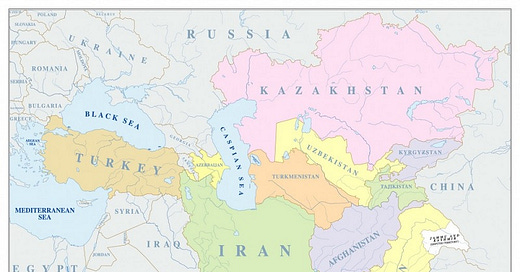At present, their combined potential is far from being fully tapped, but progress has gradually been made through two regional megaprojects, the Sino-Turkish Middle Corridor and the Russo-Indo North-South Transport Corridor.
The global systemic transition to multipolarity, which predates the start of Russia’s special operation but was unprecedentedly accelerated by it, is leading to the emergence of new economic centers. The Economic Cooperation Organization (ECO) is among those poised to play such a role. Its latest annual summit was just held in the Uzbek capital of Tashkent and saw all the attending leaders discuss ways to pioneer closer economic cooperation between their countries.
This bloc comprises the majority-Muslim former Soviet Republics, Afghanistan, Iran, Pakistan, and Turkiye, thus making it a geo-economic force to be reckoned with in the event that their ambitious plans succeed. At present, their combined potential is far from being fully tapped, but progress has gradually been made through two regional megaprojects, the Sino-Turkish Middle Corridor (MC) and the Russo-Indo North-South Transport Corridor (NSTC).
The first runs across Central Asia before crossing the Caspian Sea to Azerbaijan, after which its initial route transits through Georgia on the way to Turkiye. The Zangezur Corridor that’s supposed to be built between Azerbaijan and Armenia could optimize Azeri-Turkish trade and thus China’s and their shared ECO Central Asian partners’ too. In the event that Yerevan remains intransigent, then the newly announced route through Northern Iran could replace the Zangezur Corridor’s role in this respect.
As for the second megaproject, this one connects India with Russia via Iran but consists of three sub-corridors across Azerbaijan, the Caspian Sea, and Turkmenistan-Kazakhstan. There’s also a branch corridor from Iran to the Central Asian Republics for expanding India’s trade with those landlocked countries. Like the MC, the NSTC has also made a lot of progress since the start of Russia’s special operation due to how that development unprecedentedly accelerated preexisting multipolar processes.
Despite these two megaprojects intersecting in the South Caucasus, Caspian Sea, and Central Asia, neither their Sino-Turkish and Russo-Indo anchor states nor the ECO’s shared transit ones have coordinated their construction, but that could change regarding the last-mentioned category. It’s unrealistic to expect rivals China and India (and Russia and Turkiye to a much lesser extent) to do so for self-evident reasons, hence why this responsibility falls on that group’s members instead.
Far from competing with one another like some might think is the case, these megaprojects actually complement each other since they concern different countries, markets, and related opportunities. Additionally, it serves the concerned transit states’ interests to increase the stakes that these three non-ECO investors (China, India, and Russia, which collectively represent the RIC core of BRICS) have in these three shared spaces (the South Caucasus, Caspian Sea, and Central Asia).
The Sino-Indo dimension of that core’s rivalry might be better managed if those countries can more effectively coordinate their MC and NSTC investments with a view towards optimizing them for everyone’s benefit. Their bilateral tensions might not abate, but at least they might not spill over into those regions in the best-case scenario. For that to happen, however, the ECO needs to create the proper structures for managing all of this. The political will appears to be present, but not much has been done.
One possible solution could be for the ECO and BRICS to devise some sort of working mechanism between them in order to help with this seeing as how that’s much more viable of an option than that first-mentioned group bilaterally engaging with the three RIC countries. The latter is hypothetically possible with Russia and China, but practically impossible when it comes to India due to Pakistan’s membership in the ECO, which could serve as an obstacle for obvious reasons.
Moreover, separate bilateral frameworks might inadvertently reinforce the false optics that these two megaprojects are competing with each other, ergo another argument in favor of devising a mechanism between the ECO and BRICS as a whole. Iran’s newfound membership in the second could lead to Tehran taking the initiative in this respect, which would also elevate its standing within the ECO. It remains to be seen who makes the first move, when, and in what way, but something of the sort appears inevitable.
It's surprising that this has yet to happen considering the ECO countries’ untapped combined potential and this bloc’s geo-economic complementarity with BRICS’ RIC core, but that just goes to show how much the prior unipolar world order influenced both of their strategic calculations. It wasn’t until this system was unprecedentedly weakened as a result of the multipolar processes unleashed by Russia’s special operation that both organizations started paying more serious attention to one another.
Iran’s membership in both enables it to serve as the bridge for formally bringing them closer together, which can then lead to the ECO becoming its own pole in the emerging world order with time. There’s still a long way to go before that happens and certain intra-organizational differences must first be resolved, especially those between Pakistan-Afghanistan and to a much lesser extent Iran-Azerbaijan, but everything is moving in that direction and correspondingly inspiring optimism for the future.




